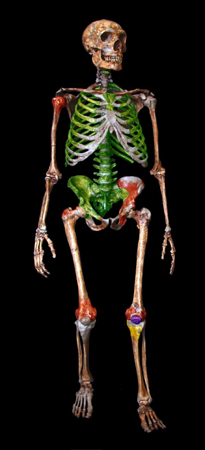Neanderthals Were Few and Poised for Extinction

Neanderthals are of course extinct. But there never were very many of them, new research concludes.
In fact, new genetic evidence from the remains of six Neanderthals (Homo neanderthalensis) suggests the population hovered at an average of 1,500 females of reproductive age in Europe between 38,000 and 70,000 years ago, with the maximum estimate of 3,500 such female Neanderthals.
"It seems they never really took off in Eurasia in the way modern humans did later," said study researcher Adrian Briggs of the Max-Planck Institute for Evolutionary Anthropology in Germany.
The research, which will be published in the July 17 issue of the journal Science, suggests the small population size of our ancestral cousins may have been a factor in their demise.
"Because there never really were millions of them, they probably were more susceptible to some event that made them go extinct, which to me, suspiciously coincides with the emergence of modern humans," Briggs told LiveScience.
Ian Tattersall, curator of anthropology at the American Museum of Natural History in New York, who was not involved in the current research, said the study "does support notions that toward the end of last ice age, the Neanderthal population was declining as a result of harsh circumstances." He added, "I don't believe Neanderthals would've gone extinct if it wasn't for this new element, the Homo sapiens competing for the same resources."
Savvy Neanderthals
Get the world’s most fascinating discoveries delivered straight to your inbox.
The Neanderthals inhabited the plains of Europe and parts of Asia as far back as 230,000 years ago. They disappeared from the fossil record more than 20,000 years ago, a few thousand years after modern humans appeared on the scene.
Figuring out why Neanderthals died out and what they were like when alive have kept plenty of scientists busy.
Rather than the dumb cavemen characters starring in Geico car insurance ads, accumulating archaeological and genetic evidence shows Neanderthals were pretty sophisticated. They apparently hunted with blades and spear tips rivaling those of modern humans, ate marine mammals like seals and dolphins and sported brains that grew like ours. Their bodies likely looked similar to ours, and some Neanderthals showed off red locks on their heads.
Sparse population
Now, Briggs and his colleagues have used a new method that targets the genetic material of interest, analyzing so-called mitochondrial DNA from the fossils of six Neanderthals, who lived between 38,000 and 70,000 years ago. That genetic material comes from females and so can be used to trace maternal lineages.
To get a sense of the genetic diversity, and ultimately population size, the team compared the Neanderthal sequences with one another. Then, the researchers looked at such genetic information from 50 living humans from around the world, asking, "how different are their genes from one another?"
(Diversity of genes can provide indirect evidence for the number of breeding individuals, because with more people mating more genes are thrown into the mix, and vice versa.)
The Neanderthals had about three times less genetic diversity than the modern humans. Briggs suggests the entire population could be roughly estimated by doubling the number of females, which they set at no higher than 3,500.
In addition, the sequenced genetic material from the Neanderthals did not support any interbreeding among Neanderthals and modern humans. However, with such a small Neanderthal population, even if interbreeding occurred, the few Neanderthal genes thrown into the mix could've been sort of diluted out over time, Briggs said.
The entire Neanderthal genome is expected to be reported later this year and could shed more light on the interbreeding question, he added.
- Top 10 Missing Links
- Neanderthal News & Information
- Neanderthals and Humans: Perhaps They Never Met
Jeanna Bryner is managing editor of Scientific American. Previously she was editor in chief of Live Science and, prior to that, an editor at Scholastic's Science World magazine. Bryner has an English degree from Salisbury University, a master's degree in biogeochemistry and environmental sciences from the University of Maryland and a graduate science journalism degree from New York University. She has worked as a biologist in Florida, where she monitored wetlands and did field surveys for endangered species, including the gorgeous Florida Scrub Jay. She also received an ocean sciences journalism fellowship from the Woods Hole Oceanographic Institution. She is a firm believer that science is for everyone and that just about everything can be viewed through the lens of science.


